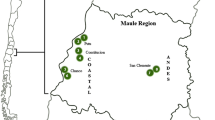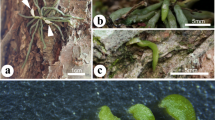Abstract
Eight endophytic fungi were isolated from roots of the threatened terrestrial orchid, Pecteilis susannae (L.) Rafin. Phylogenetic analysis based on an alignment of internal transcribed spacer regions of nuclear rDNA indicated that seven isolates belonged to the genus Epulorhiza and one to Fusarium. All fungal isolates were cultured with orchid seeds collected from three field sites near Doi Suthep-Pui National Park, Chiang Mai, Thailand. Seed germination and protocorm development were evaluated up to 70 days after sowing. Percent symbiotic seed germination was highest (86.2%) when seeds were cultured with Epulorhiza (CMU-Aug 013). The protocorm development was the most advanced up to stage 2, continued embryo enlargement, or rupture of the testa, and the highest percentage was 17.8% when seeds were cultured with Epulorhiza (CMU-Aug 007). Without fungi, seed germination and protocorm development were 62.1% and 11.1%, respectively. The dependency of P. susannae on fungal symbionts for early seedling development is yet to be determined. Optimizing seed germination and seedling fitness will assist the conservation of this threatened orchid in Thailand.






Similar content being viewed by others
References
Arditti J, Ernst R, Yam TW, Glabe C (1990) The contributions of orchid mycorrhizal fungi to seed germination: a speculative review. Lindleyana 5:249–255
Arditti J, Michaud JD, Oliva AP (1981) Seed germination of North American orchids. I. Native California and related species of Calypso, Epipactis, Goodyera, Piperia, and Platanthera. Bot Gaz 142:442–453. doi:006-807/81/4204-002S02.00
Athipunyakom P, Manoch L, Piluek C (2004a) Isolation and identification of mycorrhizal fungi from eleven terrestrial orchids. Kasetsart J (Nat Sci) 38:216–228
Athipunyakom P, Manoch L, Piluek C, Artjariyasripong S, Tragulrung S (2004b) Mycorrhizal fungi from Spathoglottis plicata and the use of these fungi to germinate seeds of S. plicata in vitro. Kasetsart J (Nat Sci) 37:83–93
Barnett HL, Hunter BB (1987) Illustrated genera of imperfect fungi fourth edition. Macmillan, New York
Batty AL, Brundrett MC, Dixon KW, Sivasithamparam K (2006a) In situ symbiotic seed germination and propagation of terrestrial orchid seedlings for establishment at field sites. Aust J Bot 54:375–381. doi:10.1071/BT04024
Batty AL, Brundrett MC, Dixon KW, Sivasithamparam K (2006b) New method to improve symbiotic propagation of temperate terrestrial orchid seedlings from axenic culture to soil. Aust J Bot 54:367–374. doi:10.1071/BT04023
Brundrett M, Bougher N, Dell B, Grove T, Malajczuk N (1996) Working with mycorrhizas in forestry and agriculture. Australian Centre for International Agricultural Research, Canberra
Brundrett M, Scade CA, Batty AL, Dixon KW, Sivasithamparam K (2003) Development of in situ and ex situ seed baiting techniques to detect mycorrhizal fungi from terrestrial orchid habitats. Mycol Res 107:1210–1220. doi:10.1017/S0953756203008463
Brundrett M, Sivasithamparam K, Ramsay M, Krauss S, Taylor R, Bunn E, Hicks A, Karim NA, Debeljak N, Mursidawati S, Dixon B, Batty A, Bower C, Brown A (2001) Orchid conservation techniques manual, first international orchid conservation congress-training course. Plant Science, King Park & Botanic Garden, Perth
Currah RS, Zelmer C (1992) A key and notes for the genera of fungi mycorrhizal with orchids and a new species in the genus Epulorhiza. Rept Tottori Mycol Inst 30:43–59
Currah RS, Zettler IW, McInnis TM (1997) Epulorhiza inquilina sp. nov. from Plantanthera (Orchidaceae) and a key to Epulorhiza species. Mycotaxon 61:335–342
Dearnaley JDW (2007) Further advances in orchid mycorrhizal research. Mycorrhiza 17:475–486. doi:s11240/s00572-007-0138-1
Felsenstein J (1985) Confidence limits on phylogenies: an approach using the bootstrap. Evolution 39:783–791. doi:10.2307/2408678
Johnson TR, Stewart SL, Dutra D, Kane ME, Richardson L (2007) Asymbiotic and symbiotic seed germination of Eulophia alta (Orchidaceae)-preliminary evidence for the symbiotic culture advantage. Plant Cell Tissue Organ Cult 90:313–323. doi:10.1007/s11240-007-9270-z
Kristiansen KA, Freudenstein JV, Rasmussen FN, Rasmussen HN (2004) Molecular identification of mycorrhizal fungi in Neuwiedia veratrifolia (Orchidaceae). Mol Phylogenet Evol 33:251–258. doi:10.106/j.ympew.2004.05.015
Ma M, Tan TK, Wong SM (2003) Identification and molecular phylogeny of Epulorhiza isolates from tropical orchids. Mycol Res 107:1041–1049. doi:10.1017/S0953756203008281
McCormick MK, Whingham DF, O'Neill J (2004) Mycorrhizal diversity in photosynthetic terrestrial orchids. New Phytol 163:425–438. doi:10.111/j.1469-8137.2004.01114x
McKendrick SL, Leaka JR, Taylor DL, Read DJ (2000) Symbiotic germination and development of myco-heterotrophic plants in nature: ontogeny of Corallorhiza trifida and characterization of its mycorrhizal fungi. New Phytol 145:523–537. doi:10.1046/j.1469-8137.2000.00603.x
McKendrick SL, Leaka JR, Taylor DL, Read DJ (2002) Symbiotic germination and development of the myco-heterotrophic orchid Neottia nidus-avis in nature and its requirement for locally distributed Sebacina spp. New Phytol 154:233–247. doi:10.1046/j.1469-8137.2002.00372.x
Nanakorn W, Indharamusika S (1998) Ex-situ conservation of native Thai orchids at Queen Sirikit Botanic Garden. Pure Appl Chem 70:2115–2122
Ovando I, Damon A, Bello R, Ambrosio D, Albores V, Adriano L, Salvador M (2005) Isolation of endophytic fungi and their potential for the tropical epiphytic orchids Cattleya skinneri. C. aurantiaca and Brassavola nodosa. Asian J Plant Sci 4:309–315. doi:10.3923/ajps.2005.309.315
Porras-Alfaro A, Bayman P (2007) Mycorrhizal fungi of Vanilla: diversity, specificity and effects on seed germination and plant growth. Mycologia 99:510–525. doi:10.3852/mycologia.99.4.510
Promputtha I, Jeewon R, Lumyong S, McKenzie EHC, Hyde KD (2005) Ribosomal DNA fingerprinting in the identification of non sporulating endophytes from Magnolia liliifera (Magnoliaceae). Fungal Divers 20:167–186
Ramsay MM, Stewart J (2008) Re-establishment of the lady's slipper orchid (Cypripedium calceolus L.) in Britain. Bot J Linn Soc 126:173–181. doi:10.1111/j.1095-8339.1998.tb02524.x
Robert P (1999) Rhizoctonia-forming fungi a taxonomic guide. The Trustees, Royal Botanic Gardens, Kew
Santisuk T, Chayamarit K, Pooma R, Suddee S (2006) Thailand red data: plants. Office of Natural Resources and Environmental Policy and Planning (ONEP), Bangkok
Shimura H, Sadamoto M, Matsuura M, Kawahara T, Naito S, Koda Y (2009) Characterization of mycorrhizal fungi isolated from the threatened Cypripedium macranthos in a northern island of Japan: two phylogenetically distinct fungi associated with the orchids. Mycorrhiza 19:525–534. doi:10.1007/s00572-009-0251-4
Smith SE, Read DJ (1997) Mycorrhizal symbiosis, second edition. Academic, San Diego, pp 348–379
Stewart SL, Kane ME (2006) Symbiotic seed germination of Habenaria macroceratitis (Orchidaceae), a rare Florida terrestrial orchid. Plant Cell Tissue Organ Cult 86:159–167. doi:10.1007/s11240-006-9104-4
Stewart SL, Zettler LW (2002) Symbiotic germination of three semi-aquatic rein orchids (Habenaria repens, H. quinquiseta, H. macroceratitis) from Florida. Aquat Bot 72:25–35. doi:10.1016/S0304-3770(01)00214-5
Suarez JP, Weiss M, Abele A, Garnica S, Oberwinkler F, Kottke I (2006) Diverse tulasnelliod fungi from mycorrhizas with epiphytic orchids in an Andean cloud forest. Mycol Res 110:1257–1270. doi:10.1016/j.mycres.2006.08.004
Swarts ND, Dixon KW (2009) Terrestrial orchid conservation in the age of extinction. Ann Bot 104:543–556. doi:10.1093/aob/mcp025
Swofford DL (2002) PAUP*: Phylogenetic analysis using parsimony (*and other methods), beta version 4.0b10. Sinauer, Sunderland
Tao G, Liu ZY, Hyde KD, Liu XZ, Yu ZN (2008) Analysis reveals novels and endophytic fungi in Bletilla ochracea (Orchidaceae). Fungal Divers 33:101–122
Taylor DL, McCormick MK (2007) Internal transcribes spacer primers and sequences for improved characterization of basidiomycetous orchid mycorrhizas. New Phytol 177:1020–1033. doi:10.1111/j.1469-8137.2007.02320.x
White TJ, Bruns TD, Lee S, Taylaor JW (1990) Amplification and direct sequencing of fungal ribosomal RNA genes for phylogenetics. In: Innis MA, Gelfand DH, Sninsky JJ, White TJ (eds) PCR protocols: a guide to methods and applications. Academic, San Diego, pp 315–322
Wright M, Cross R, Dixon K, Huynh T, Lawrie A, Nesbitt L, Prichard A, Swarts N, Thomson R (2009) Propagation and reintroduction of Caladenia. Aust J Bot 57:373–387. doi:10.1071/BT08137
Yamato M, Yagame T, Suzuki A, Iwase K (2005) Isolation and identification of mycorrhizal fungi associating with an achlorophyllus plant, Epipogium rosesum (Orchidaceae). Mycoscience 46:73–77. doi:10.1007/s10267-004-0218-4
Zelmer CD, Cuthbertson L, Currah RS (1996) Fungi associated with terrestrial orchid mycorrhizas, seeds and protocorms. Mycoscience 37:439–448. doi:10.1007/BF02461001
Zettler LW, Hofer CJ (1998) Propagation of the little club-spur orchid (Platanthera clavellata) by symbiotic seed germination and its ecological implications. Environ Exp Bot 39:189–195. doi:10.1016/S0098-8472(97)00019-1
Zhu GS, Yu ZN, Gui Y, Liu ZY (2008) A novel technique for isolating orchid mycorrhizal fungi. Fungal Divers 33:123–137
Acknowledgements
This work was supported by the office of the Higher Education Commission, Thailand under the program Strategic Scholarship for frontier Research Network for Join Ph.D. Program, National Research University and Graduate School of Chiang Mai University. We are also grateful to Buasoy Mala for providing orchid samples at Queen Sirikit Botanic Garden and other colleagues in the Department of Biology, Faculty of Science, Chiang Mai University for laboratory assistance.
Author information
Authors and Affiliations
Corresponding author
Rights and permissions
About this article
Cite this article
Chutima, R., Dell, B., Vessabutr, S. et al. Endophytic fungi from Pecteilis susannae (L.) Rafin (Orchidaceae), a threatened terrestrial orchid in Thailand. Mycorrhiza 21, 221–229 (2011). https://doi.org/10.1007/s00572-010-0327-1
Received:
Accepted:
Published:
Issue Date:
DOI: https://doi.org/10.1007/s00572-010-0327-1




